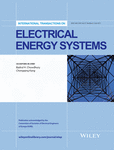Gaussian mixture model-based neural network for short-term wind power forecast
Corresponding Author
Gary W. Chang
Department of Electrical Engineering, National Chung Cheng University, Chiayi, Taiwan
Correspondence
G. W. Chang, Department of Electrical Engineering, National Chung Cheng University, Chiayi 62102, Taiwan.
Email: [email protected]
Search for more papers by this authorHeng-Jiu Lu
Department of Electrical Engineering, National Chung Cheng University, Chiayi, Taiwan
Search for more papers by this authorPing-Kui Wang
Department of Electrical Engineering, National Chung Cheng University, Chiayi, Taiwan
Search for more papers by this authorYung-Ruei Chang
Institute of Nuclear Energy Research, Taoyuan, Taiwan
Search for more papers by this authorYee-Der Lee
Institute of Nuclear Energy Research, Taoyuan, Taiwan
Search for more papers by this authorCorresponding Author
Gary W. Chang
Department of Electrical Engineering, National Chung Cheng University, Chiayi, Taiwan
Correspondence
G. W. Chang, Department of Electrical Engineering, National Chung Cheng University, Chiayi 62102, Taiwan.
Email: [email protected]
Search for more papers by this authorHeng-Jiu Lu
Department of Electrical Engineering, National Chung Cheng University, Chiayi, Taiwan
Search for more papers by this authorPing-Kui Wang
Department of Electrical Engineering, National Chung Cheng University, Chiayi, Taiwan
Search for more papers by this authorYung-Ruei Chang
Institute of Nuclear Energy Research, Taoyuan, Taiwan
Search for more papers by this authorYee-Der Lee
Institute of Nuclear Energy Research, Taoyuan, Taiwan
Search for more papers by this authorSummary
The wind power forecast has attracted much attention in recent years because of the significantly increasing number of large-scale integrations of the wind power plants in the electric grid. In this paper, a Gaussian mixture model-based neural network model is proposed to forecast the short-term wind power generation. Actual measured wind power output data are adopted to train the proposed model. Test results of wind power obtained by autoregressive integrated moving average, radial basis function neural network, support vector regression, and the proposed method are then under comparisons. It shows that the proposed method can provide more accurate forecast of short-term wind power output than other compared methods.
REFERENCES
- 1Tascikaraoglu A, Uzunoglu M. A review of combined approaches for prediction of short-term wind speed and power. Renew Sust Energ Rev. 2014; 34: 243–254.
- 2Bathurst GN, Weatherhill J, Strbac G. Trading wind generation in short-term energy markets. IEEE Trans on Power System. 2002; 17: 782–789.
- 3Ackermann T. Wind Power in Power Systems. 2nd ed. Stockholm, Sweden: Wiley; 2012.
10.1002/9781119941842 Google Scholar
- 4Wang J, Song Y, Liu F, Hou R. Analysis and application of forecasting models in wind power integration: a review of multi-step-ahead wind speed forecasting models. Renew Sust Energ Rev. 2016; 60: 960–981.
- 5Soman SS, Zareipour H, Malik O, Mandal P. A review of wind power and wind speed forecasting methods with different time horizons. North American Power Symposium (NAPS). 2010; 1–8.
- 6Shukur OB, Lee MH. Daily wind speed forecasting through hybrid KF-ANN model based on ARIMA. Renew Energy. 2015; 76: 637–647.
- 7Kavousi-Fard A, Khosravi A, Nahavandi S. A new fuzzy-based combined prediction interval for wind power forecasting. IEEE Trans on Power Systems. 2016; 31: 18–26.
- 8Hu Q, Zhang S, Yu M, et al. Short-term wind speed or power forecasting with heteroscedastic support vector regression. IEEE Trans on Sustainable Energy. 2016; 7: 241–249.
- 9Amjady N, Keynia F, et al. A new hybrid iterative method for short-term wind speed forecasting. International Trans on Electrical Power. 2010; 22: 581–595.
- 10Osório GJ, Matias JCO, Catalão JPS. Short-term wind power forecasting using adaptive neuro-fuzzy inference system combined with evolutionary particle swarm optimization, wavelet transform and mutual information. Renew Energy. 2015; 75: 301–307.
- 11Kelouwani S, Agbossou K. Nonlinear model identification of wind turbine with a neural network. IEEE Trans Energy Conversion. 2004; 19: 607–612.
- 12Bhaskar K, Singh SN. AWNN-assisted wind power forecasting using feed-forward neural network. IEEE Trans. Sustainable Energy. 2012; 3: 306–315.
- 13Yan J, Li K, Bai EW, et al. Hybrid probabilistic wind power forecasting using temporally local Gaussian process. IEEE Trans on Sustainable Energy. 2016; 7: 87–95.
- 14Zhang Y, Wang J, Wang X. Review on probabilistic forecasting of wind power generation. Renew Sustain Energy Rev. 2014; 32: 255–270.
- 15Can W, Zhao X, Pinson P, et al. Probabilistic forecasting of wind power generation using extreme learning machine. IEEE Trans on Power Systems. 2014; 29: 1033–1044.
- 16Alessandrini S, Delle Monache L, Sperati S, et al. A novel application of an analog ensemble for short-term wind power forecasting. Renew Energy. 2015; 76: 768–781.
- 17Haykin H. Neural Networks and Learning Machines: A Comprehensive Foundation. 3rd ed. NJ: Prentice Hall; 2008.
- 18Xiong G, Feng C, Ji L. Dynamical Gaussian mixture model for tracking elliptical living objects. Pattern Recogn Lett. 2006; 27: 838–842.
- 19Du J, Hu Y, Jiang H. Boosted mixture learning of Gaussian mixture hidden Markov models based on maximum likelihood for speech recognition. IEEE Trans Audio Speech Lang Process. 2011; 19: 2091–2100.
- 20Celik T, Tjahjadi T. Automatic image equalization and contrast enhancement using Gaussian mixture modeling. IEEE Trans on Image Processing. 2012; 21: 145–156.
- 21Valverde G, Saric AT, Terzija V. Probabilistic load flow with non-Gaussian correlated random variables using Gaussian mixture models. IET Gener Transm Distrib. 2012; 6: 701–709.
- 22Singh R, Pal BC, Jabr RA. Distribution system state estimation through Gaussian mixture model of the load as pseudo-measurement. IET Gener, Transm Distrib. 2010; 4: 50–59.
- 23Ke D, Chung CY, Sun Y. A novel probabilistic optimal power flow model with uncertain wind power generation described by customized Gaussian mixture model. IEEE Trans on Sustainable Energy. 2016; 7: 200–212.
- 24Reynolds DA. Gaussian mixture models. Encyclopedia of Biometric Recognition. 2009; 659–663.
- 25Shi J, Ding Z, Lee WJ, et al. Hybrid forecasting model for very-short term wind power forecasting based on grey relational analysis and wind speed distribution features. IEEE Trans on Smart Grid. 2014; 5: 521–526.
- 26Kecman V. Support Vector Machines–An Introduction. New York: Springer; 2005.
10.1007/10984697_1 Google Scholar




